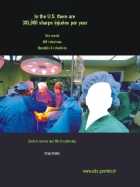STOP STICKS CAMPAIGN



Sharps Injuries: Bloodborne Pathogens
Bloodborne pathogens and workplace sharps injuries
Human immunodeficiency virus (HIV), hepatitis B virus (HBV), and hepatitis C virus (HCV) are three of the most common bloodborne pathogens from which health care workers are at risk. Health care workers are potentially exposed to these diseases in one of two ways:
- A percutaneous injury in which a health care worker is injured by a sharps object, or
- Contact of mucous membrane or non-intact skin with blood, tissue, or other potentially infectious bodily fluids.
Human immunodeficiency virus (HIV)
Overview
Human immunodeficiency virus (HIV) disables the body's immune system until it is no longer capable of fighting infection. Once a person becomes immunocompromised, he or she can exhibit symptoms of weight loss, persistent low-grade fever, night sweats, and flu-like symptoms. The person is also more vulnerable to pneumonias, intestinal disorders, and fungal infections.
Risk of injury and transmission
The estimated risk of HIV infection from a sharps injury is about 0.3 percent (1 in 300). The CDC has reported 57 documented cases and 140 possible cases of HIV transmission to U.S. health care workers between 1981 and December 2006. Of the 57 documented cases, 48 were associated with percutaneous injury (puncture/cut injury).
Most of these cases involved nurses and lab technicians. Other researchers estimate that the number of cases of occupationally acquired infections is much higher.
Hepatitis B virus (HBV)
Overview
Hepatitis B virus can cause serious liver damage and death. Symptoms include jaundice, fever, nausea, and abdominal pain. Approximately 5 to 10 percent of patients develop chronic infection with hepatitis B, which carries an estimated 20 percent lifetime risk of dying from cirrhosis and 6 percent risk of dying from liver cancer. The chance of becoming infected with hepatitis B from a sharps injury is estimated to be between 6 and 30 percent.
Risk of injury and transmission
National hepatitis surveillance data shows that approximately 400 health care workers became infected with HBV in 2001. This figure represented a 95% decline from the 17,000 new infections estimated in 1983. The decline was largely due to the widespread immunization of health care workers with hepatitis B vaccine and the use of universal precautions and other measures required by OSHA.
Hepatitis C virus (HCV)
Overview
Hepatitis C virus causes serious damage to the liver and can be fatal. Infection can occur without symptoms or only mild ones. Chronic hepatitis develops in 75 to 80 percent of infected patients, and 70 percent of these individuals get active liver disease. Of those with active liver disease, 10 to 20 percent develop cirrhosis and 1 to 5 percent develop liver cancer.
Risk of injury and transmission
Although the prevalence of HCV infection among health care workers is similar to that in the general population (1% to 2%), health care workers have an increased occupational risk for HCV infection. According to the CDC, the average risk of infection after a needlestick or cut exposure to infected blood is approximately 1.8%. Although recent studies show an association between sharps injuries and HCV infection, the number of health care workers who have acquired HCV occupationally is unknown. However, of the total acute HCV infections that have occurred annually (ranging from 100,000 in 1991 to 36,000 in 1996), 2% to 4% have been health care workers exposed to blood in the workplace.
- Page last reviewed: September 28, 2010
- Page last updated: September 28, 2010
- Content source:
- Centers for Disease Control and Prevention
- Page maintained by: Office of Associate Director of Communication, Division of Public Affairs


 ShareCompartir
ShareCompartir